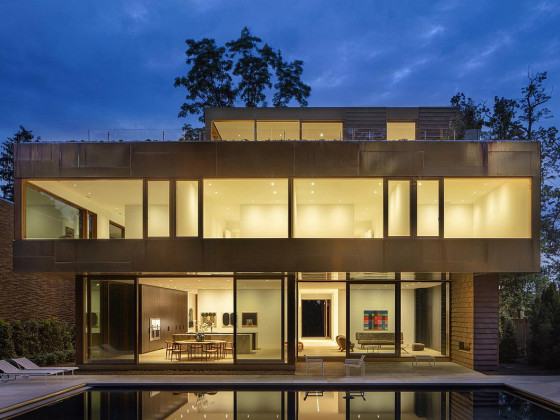What's Hot: Nicklas Backstrom's $12 Million McLean Home Finds A Buyer | HPO Recommends Approval Of Georgetown Conversion
 DC's Missing Middle
DC's Missing Middle
✉️ Want to forward this article? Click here.

The population of the District has grown at a rapid clip over the past decade. The vast majority of this population growth has been courtesy of millennials, a cohort which, along with seniors, is finding urban areas more desirable yet experiencing difficulty finding housing that both suits their needs while being affordable.
This gap in housing is known as the “missing middle”, and a panel at the ULI Washington Real Estate Trends conference on Tuesday discussed the concept and how DC is trying (and failing) to address housing for the aforementioned groups.
The term “missing middle” was coined by architect Daniel Parolek to describe the dearth of housing types — somewhere between single-family homes and mid-rise multi-family buildings — that would accommodate the needs of a large swath of the middle class.
These underserved households typically earn between 80-120 percent of area median income (roughly $60,500-90,800 in the DC area) and is best typified by millennials and seniors who value the walkability and amenity-rich lifestyle the urban core provides. Their income enables them to afford a monthly mortgage, although likely not a down payment, for a home. Although condominiums posed a viable entry-level housing option prior to the recession, they have fallen out of demand compared to townhouses since the housing recovery.
Developers in DC have been delivering new housing that serves single-person households in order to catch up with that segment of demand; conversely, that demand has begun to plateau while other housing needs go unmet. Members of the ULI panel noted that efforts toward creating housing for the missing middle would de-concentrate poverty east of the Anacostia River while diversifying upper Northwest.
story continues below
loading...story continues above
Panelist and former Office of Planning director Harriet Tregoning noted that recent zoning changes to allow by-right accessory dwelling units could go a long way toward creating infill housing that is virtually invisible yet increases density. Conversely, some neighborhoods have been downzoned, which is antithetical to the idea of creating additional housing and increasing density.
Ideally, zoning regulations would be changed to accommodate density of 50 or more dwelling units per acre as a rule of thumb. Various sorts of modular stacked flats, which are rare in the DC area as compared to the south or the western regions of the country, would go a long way toward addressing the missing middle. KTGY Architecture + Planning principal Rohit Anand pointed out that this housing would serve the “urban tribes”: DINKs (Double Income No Kids), WINKs (Women with Income and No Kids), Huppies (Hipster Urban Professionals) and HENRYs (High-Earners, Not Rich Yet).
These tribes prize flexible space above all, desiring the ability to work from home and have space for their family to grow into over time. Panelist Evan Regan-Levine of the JBG Companies said that this flexibility extends beyond just an open floorplan; households may want to be able to rent out a basement, for example, in order to offset their housing costs and supplement what is essentially a taxing investment. Eventually, that rental unit may need to be reincorporated into the household as a workspace, and then again later as a nursery.
The panelists agreed that the primary way to address the missing middle is flexible zoning: more mixed-income, mixed-use developments should be created that also incorporate multiple densities within one project, industrial zones should be converted or re-zoned to better integrate residential uses and seamlessly blend live-work situations, and that zoning should be more cognizant of location in order to spread density in neighborhoods west of Rock Creek Park.
In the near-term, the current movement to update the DC Comprehensive Plan poses an opportunity to urge more housing that addresses the needs of the missing middle. The sort of medium-density modular housing that would be most suitable is not something that city-dwellers should feel threatened by or see as antithetical to the character of their neighborhoods; as Regan-Levine notes, it is a “return to form that replicates the urban infill model” that has already been in place in much of the city.
See other articles related to: missing middle dc
This article originally published at http://dc.urbanturf.production.logicbrush.com/articles/blog/dcs_missing_middle/12493.
Most Popular... This Week • Last 30 Days • Ever

With frigid weather hitting the region, these tips are important for homeowners to ke... read »

Today, UrbanTurf offers a brief explanation of what it means to lock in an interest r... read »

A new report from DC’s Office of Revenue Analysis highlights how millennials and wo... read »

The number of neighborhoods in DC where the median home price hit or exceeded $1 mill... read »

An application extending approval of Friendship Center, a 310-unit development along ... read »
DC Real Estate Guides
Short guides to navigating the DC-area real estate market
We've collected all our helpful guides for buying, selling and renting in and around Washington, DC in one place. Start browsing below!
First-Timer Primers
Intro guides for first-time home buyers
Unique Spaces
Awesome and unusual real estate from across the DC Metro













